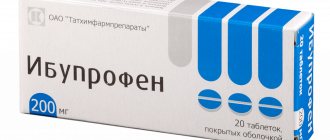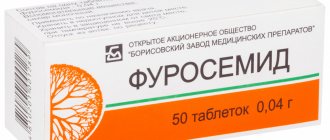Publications in the media
(Acetazolamidum) INN
Synonyms. Diakarb, Fonurit.
Composition and release form. Acetazolamide tablets 0.25 g.
Indications. Edema resulting from pulmonary heart failure; glaucoma (various phases of development); epilepsy.
Pharmachologic effect. Acetazolamide is a carbonic anhydrase inhibitor and increases the renal excretion of bicarbonate from the body, causing an increase in urine pH. It acts in the proximal tubules of the kidneys and, by inhibiting carbonylase, leads to a decrease in the formation of carbonic acid; At the same time, the excretion of sodium and potassium from the body increases. Chloride excretion does not increase. Long-term use of acetazolamide causes a negative sodium and water balance combined with the development of hyperchloremic acidosis. Increased urinary excretion of sodium and bicarbonates significantly increases the excretion of water from the body. Acetazolamide lowers intraocular pressure, reducing the secretion of aqueous humor by 50-60% (inhibition of carbonic anhydrase of the ciliary body). The anticonvulsant effect of acetazolamide may be associated with inhibition of brain carbonic anhydrase activity and a decrease in the formation of cerebrospinal fluid.
Pharmacokinetics. The drug is quickly absorbed from the gastrointestinal tract into the blood when taken orally. The connection with plasma proteins is high - 90%. T1/2 is from 10 to 15 hours. Peak plasma concentration when taking a dose of 500 mg is reached after 2-4 hours and is 12-27 mcg/ml. The drug is excreted unchanged by the kidneys; 90 to 100% of the dose taken is excreted within 24 hours after oral administration of the tablets. The duration of action of the drug from slow-release capsules is 18-24 hours.
Side effects. Drowsiness, disorientation, paresthesia; hypokalemia, metabolic acidosis; fatigue and weakness; diarrhea; general feeling of discomfort; increased frequency of the urge to urinate; decreased appetite; metallic taste in the mouth, nausea or vomiting; weight loss; numbness, tingling or burning sensation in the hands, toes, mouth, burning sensation of the tongue, lips or anus.
Contraindications. Adrenal insufficiency (Addison's disease); hyperchloremic acidosis, hypokalemia, hyponatremia; acute liver and kidney diseases; diabetes; first trimester of pregnancy; hypersensitivity to the drug.
Adverse reactions when interacting with other drugs. When taking amphetamines or anticholinergics (especially the atropine group), or quinidine with acetazolamide, the therapeutic and side effects of the former are enhanced and prolonged as a result of a decrease in their excretion in alkaline urine. The hypoglycemic effect of oral antidiabetic agents and insulin may be reduced when taken concomitantly with acetazolamide, which can cause hyperglycemia and glycosuria in patients with diabetes mellitus. Concomitant use of ciprofloxacin and acetazolamide reduces the solubility of ciprofloxacin in the urine, and patients may experience signs of crystalluria and nephrotoxicity. The toxicity of cardiac glycosides increases when taken together with acetazolamide, which causes hypokalemia. The risk of salicylate intoxication in patients receiving large doses of salicylates increases when they are taken simultaneously with acetazolamide, since the metabolic acidosis caused by the latter increases the penetration of salicylates into the brain.
Information for the patient. Acetazolamide is recommended to be taken on an empty stomach, but if there are signs of irritation of the gastric mucosa, it can be taken with food. As a diuretic, 0.125-0.25 g is usually prescribed once a day or every other day in courses of 2-4 days. For glaucoma, 0.125-0.25 g is prescribed 1-3 times a day. Missed dose - see hydrochlorothiazide. To correct the electrolyte balance during long-term use of acetazolamide, it is necessary to administer sodium bicarbonate and potassium. In elderly patients, potassium excretion under the influence of acetazolamide increases, so it is recommended to limit yourself to 1-2 daily courses of taking the drug. Adequate fluid intake is important during acetazolamide therapy to prevent the formation of renal stones (especially in patients with hypercalciuria and gout). Patients receiving carbonic anhydrase inhibitors should include dietary supplements containing potassium or be prescribed potassium supplements.
Acetazolamide
The drug is taken orally, strictly as prescribed by the doctor.
If you miss a dose of the drug, do not increase the dose at the next dose.
Edema syndrome
At the beginning of treatment, take 250 mg in the morning. To achieve the maximum diuretic effect, it is necessary to take the drug Acetazolamide 1 time per day, every other day or 2 days in a row with a one-day break. Increasing the dose does not enhance the diuretic effect.
If the previously achieved response to acetazolamide therapy decreases, the drug should be discontinued for a day (to restore the activity of carbonic anhydrase in the kidneys). The use of acetazolamide does not replace the need to use other medications, stay in bed, and limit sodium chloride intake.
Glaucoma
Acetazolamide should be taken as part of complex therapy.
Adults with open-angle glaucoma
the drug is prescribed in a dose of 250 mg 1-4 times a day. Doses exceeding 1000 mg do not increase the therapeutic effect. For secondary glaucoma, the drug is prescribed at a dose of 250 mg every 4 hours during the day. In some patients, the therapeutic effect appears after short-term administration of the drug at a dose of 250 mg 2 times a day.
For acute attacks of glaucoma:
the drug is prescribed 250 mg 4 times a day.
Children over 3 years old with attacks of glaucoma
the drug is prescribed at a dose of 10-15 mg/kg body weight per day in 3-4 doses.
After 5 days of taking it, take a break for 2 days. With long-term treatment, it is necessary to prescribe potassium supplements and a potassium-sparing diet.
In preparation for surgery, 250-500 mg is prescribed the day before and on the morning of the operation. Epilepsy
Doses for adults:
250-500 mg/day in one dose for 3 days, break on the 4th day. When using Acetazolamide simultaneously with other anticonvulsants, at the beginning of treatment, use 250 mg 1 time per day, gradually increasing the dose if necessary. The maximum daily dose in adults is 1000 mg.
Doses for children over 3 years of age:
8-30 mg/kg per day, divided into 1-4 doses. The maximum daily dose is 750 mg.
Acute altitude sickness
It is recommended to use the drug at a dose of 500-1000 mg per day.
In case of rapid ascent - 1000 mg per day.
The drug should be used 24-48 hours before climbing. If symptoms of illness appear, treatment is continued for the next 48 hours or longer if necessary.
Liquorodynamic disturbances, intracranial hypertension
It is recommended to use the drug at a dose of 250 mg per day or 125-250 mg every 8-12 hours. The maximum therapeutic effect is achieved when taking a dose of 750 mg per day. To achieve optimal effect, daily non-interval use of the drug may be required.
Details in the instructions for use.
Acetazolamide
Acetazolamide is a systemic carbonic anhydrase inhibitor with weak diuretic activity. Carbonic anhydrase (CA) is an enzyme involved in the hydration of carbon dioxide and dehydration of carbonic acid. Inhibition of carbonic anhydrase reduces the formation of bicarbonate ions with a subsequent decrease in sodium transport into cells.
The effects of using acetazolamide drugs are determined by the point of application of the molecule: the choroid plexuses of the brain, the proximal nephron, the ciliary body of the eye, and red blood cells.
Acetazolamide is used to treat CSF flow disorders and intracranial hypertension by reducing excess CSF production at the level of the choroid plexuses of the brain. Inhibition of carbonic anhydrase in ependymocytes of the choroid plexus reduces the excess negative charge in ependymal cells and reduces the gradient filtration of plasma into the cavity of the ventricles of the brain.
Acetazolamide is used in the treatment of edema syndrome due to its weak diuretic effect. As a result of inhibition of carbonic anhydrase activity in the proximal nephron, the formation of carbonic acid decreases and the reabsorption of bicarbonate and sodium ions by the tubular epithelium decreases, and therefore the release of water significantly increases.
Acetazolamide increases the excretion of bicarbonates, which can lead to the development of metabolic acidosis. Acetazolamide causes the kidneys to excrete phosphates, magnesium, and calcium, which can also lead to metabolic disorders. Over the next three days of therapy, the reabsorption of sodium ions in the distal nephron is compensatorily activated, reducing the diuretic effect of acetazolamide.
After 3 days from the start of use, acetazolamide loses its diuretic properties. After a break in treatment for several days, newly prescribed acetazolamide resumes its diuretic effect due to the restoration of normal carbonic anhydrase activity in the proximal nephron.
Acetazolamide is used to treat glaucoma. During the formation of aqueous humor of the eye, bicarbonate ions (HCO3-) are actively transported into the posterior chamber from the cytoplasm of non-pigmented cells to compensate for the positive ion gradient caused by the active transport of sodium ions.
CA inhibitors block the formation of carbonic acid, thus reducing the production of HCO3- ions. In the absence of sufficient HCO3- ions, the positive ion gradient increases, which causes a decrease in the secretion of aqueous humor. Inhibition of carbonic anhydrase of the ciliary body reduces the secretion of aqueous humor in the anterior chamber of the eye, which reduces intraocular pressure. Tolerance to this effect does not develop.
Iphthalmotonus when taking acetazolamide begins to decrease after 40-60 minutes, the maximum effect is observed after 3-5 hours, intraocular pressure remains below the initial level for 6-12 hours. On average, intraocular pressure decreases by 40-60% from the initial level.
Acetazolamide is used as an adjuvant in the treatment of epilepsy, because inhibition of carbonic anhydrase in nerve cells of the brain inhibits pathological excitability.
Acetazolamide as a diuretic
Acetazolamide as a diuretic is used 250-375 mg per day orally or intravenously.
Prescription for acetazolamide
- Rp. (Recipe): Acetazolamidi 125 mg Dtd n 10 (Da tales doses numero 10) in Tab. (in Tabulettis) S. (Signa) Orally, 1 tablet 2 times a day.
- Rp. (Recipe): Acetazolamidi 250 mg Dtd n. 10 in tab. S. Orally 1 tablet 1 time per day.
Recipe for diacarb
- Rp.: Tab. “Diakarb” Dtd n 30 (30 tablets in a pack, as seen in the picture) S. Orally, 1 tablet 1 time per day.
- Rp.: Tab. (Tabulettas) “Diakarb” N. 30 DS (Da Signa) 1 tablet 1 time per day.
Diamox recipe
- Rp.: Tab. “Diamox” Dtd n 100 (100 tablets in a pack, as seen in the picture) S. Orally, 1 tablet 1 time per day.
Acetazolamide, 30 pcs., 250 mg, tablets
Acetazolamide is a systemic carbonic anhydrase inhibitor with weak diuretic activity. Carbonic anhydrase (CA) is an enzyme involved in the hydration of carbon dioxide and dehydration of carbonic acid. Inhibition of carbonic anhydrase reduces the formation of bicarbonate ions with a subsequent decrease in sodium transport into cells.
The effects of using acetazolamide drugs are determined by the point of application of the molecule: the choroid plexuses of the brain, the proximal nephron, the ciliary body of the eye, and red blood cells.
Acetazolamide is used to treat CSF flow disorders and intracranial hypertension by reducing excess CSF production at the level of the choroid plexuses of the brain. Inhibition of carbonic anhydrase in ependymocytes of the choroid plexus reduces the excess negative charge in ependymal cells and reduces the gradient filtration of plasma into the cavity of the ventricles of the brain.
Acetazolamide is used in the treatment of edema syndrome due to its weak diuretic effect. As a result of inhibition of carbonic anhydrase activity in the proximal nephron, the formation of carbonic acid decreases and the reabsorption of bicarbonate and sodium ions by the tubular epithelium decreases, and therefore the release of water significantly increases.
Acetazolamide increases the excretion of bicarbonates, which can lead to the development of metabolic acidosis. Acetazolamide causes the kidneys to excrete phosphates, magnesium, and calcium, which can also lead to metabolic disorders. Over the next three days of therapy, the reabsorption of sodium ions in the distal nephron is compensatorily activated, reducing the diuretic effect of acetazolamide.
After 3 days from the start of use, acetazolamide loses its diuretic properties. After a break in treatment for several days, newly prescribed acetazolamide resumes its diuretic effect due to the restoration of normal carbonic anhydrase activity in the proximal nephron.
Acetazolamide is used to treat glaucoma. During the formation of aqueous humor of the eye, bicarbonate ions (HCO3-) are actively transported into the posterior chamber from the cytoplasm of non-pigmented cells to compensate for the positive ion gradient caused by the active transport of sodium ions.
CA inhibitors block the formation of carbonic acid, thus reducing the production of HCO3- ions. In the absence of sufficient HCO3- ions, the positive ion gradient increases, which causes a decrease in the secretion of aqueous humor. Inhibition of carbonic anhydrase of the ciliary body reduces the secretion of aqueous humor in the anterior chamber of the eye, which reduces intraocular pressure. Tolerance to this effect does not develop.
Iphthalmotonus when taking acetazolamide begins to decrease after 40-60 minutes, the maximum effect is observed after 3-5 hours, intraocular pressure remains below the initial level for 6-12 hours. On average, intraocular pressure decreases by 40-60% from the initial level.
Acetazolamide is used as an adjuvant in the treatment of epilepsy, because inhibition of carbonic anhydrase in nerve cells of the brain inhibits pathological excitability.






